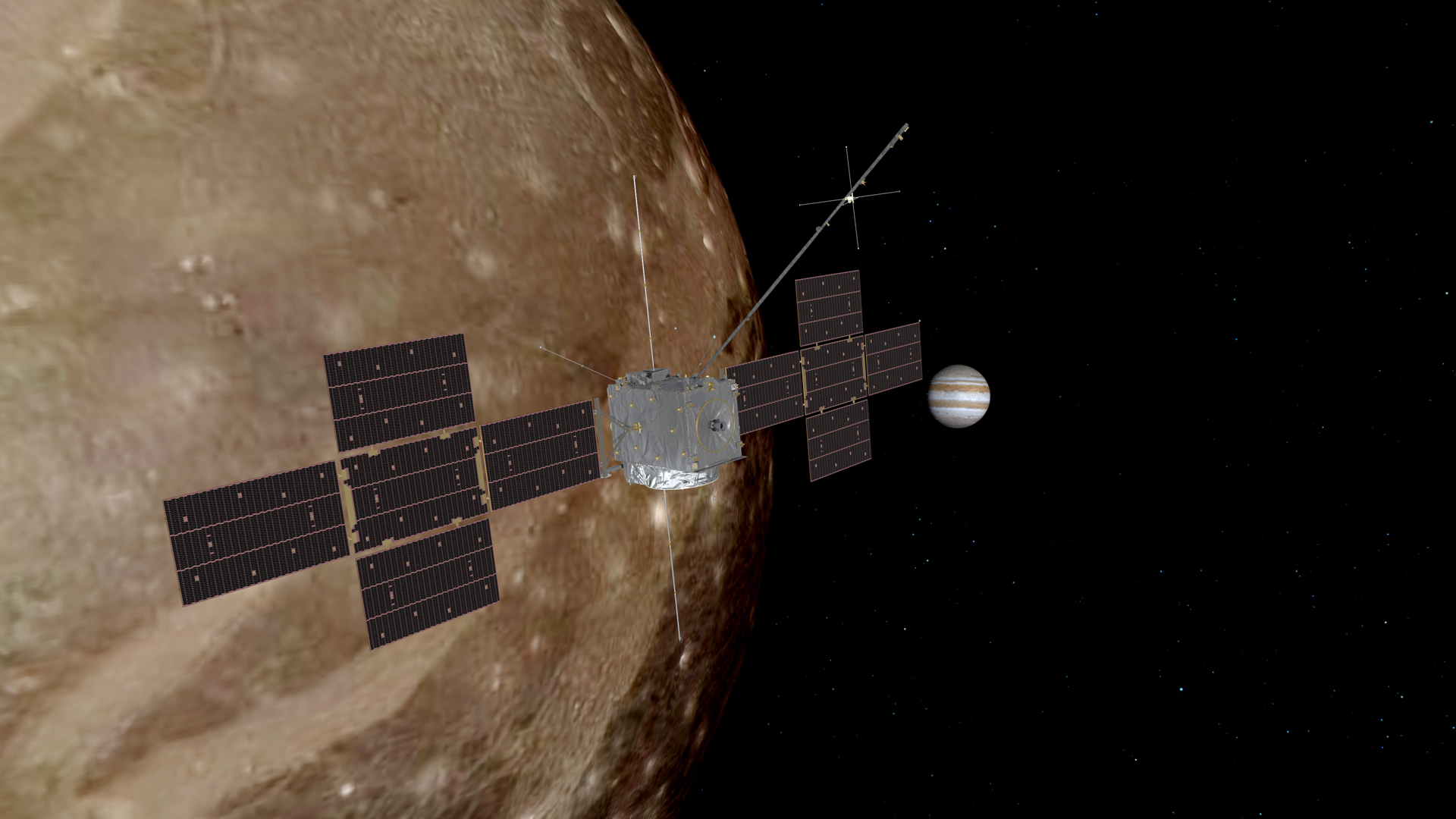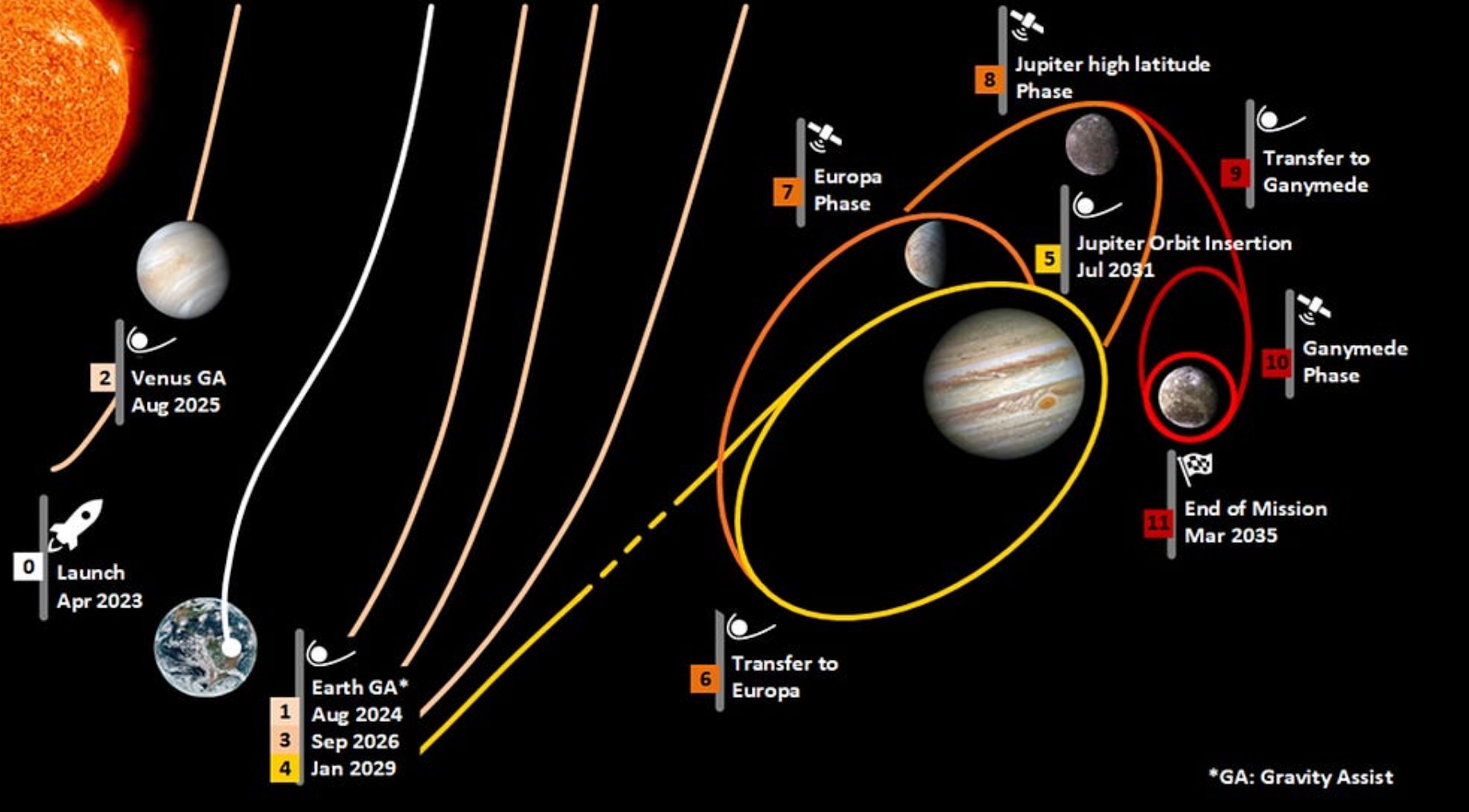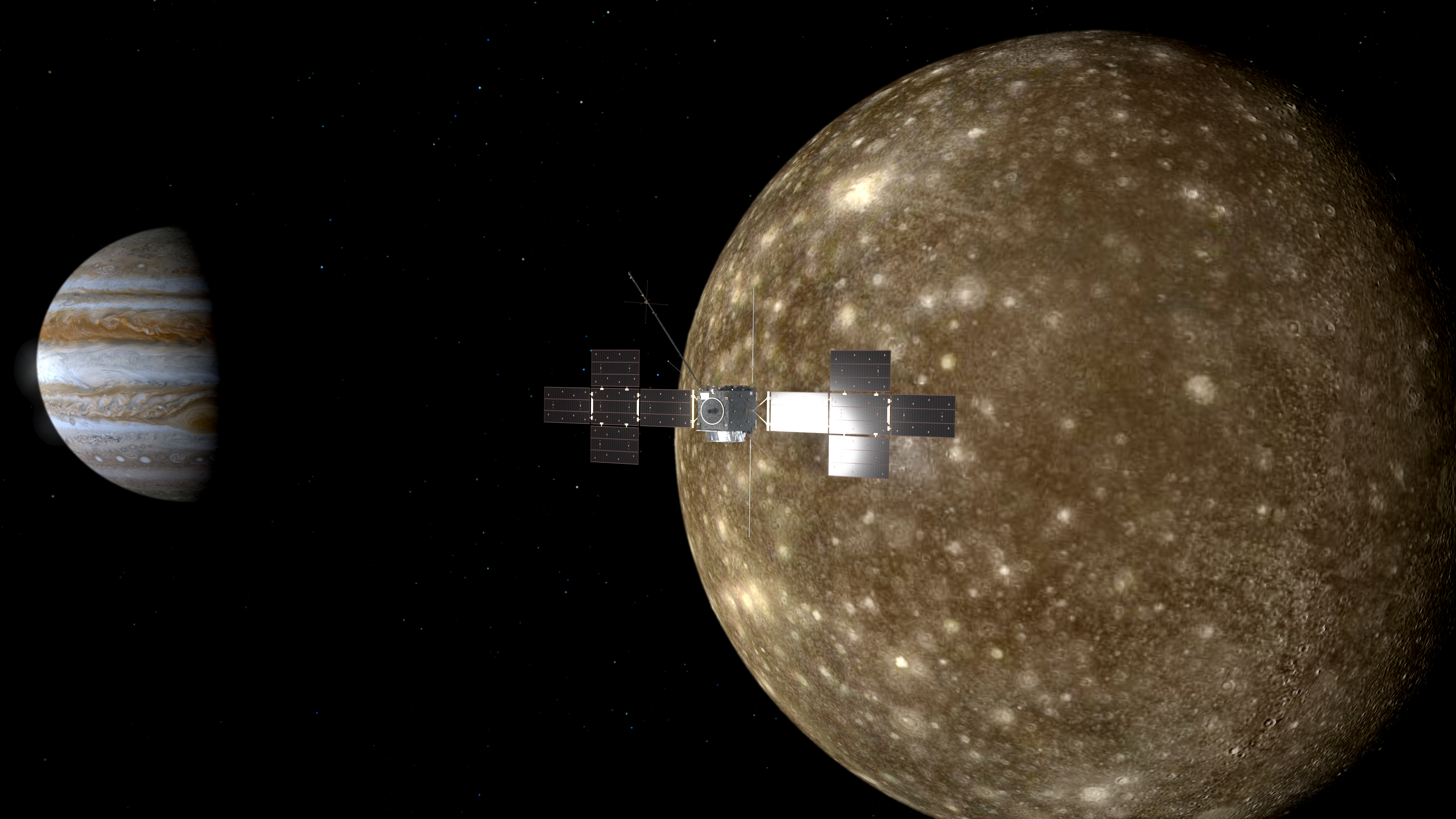What's next for Europe's JUICE mission? Here's what to expect on its long journey to Jupiter
JUICE's journey to Jupiter includes fly-bys of Venus and Earth.

The European Space Agency's (ESA) flagship mission to Jupiter and its icy moons is underway.
But after the successful launch of the JUICE (Jupiter Icy Moons Explorer) spacecraft, what's next for the 1.6 billion euro ($1.77 billion) mission to Jupiter?
After blasting off into the sky above Europe's spaceport in French Guiana, JUICE now embarks on an eight-year journey that will see it perform fly-bys of Venus and Earth to gain gravity assists that will accelerate it to an encounter with Jupiter in 2031.
But the long journey does not mean that mission scientists will get to put their feet up for eight years. In fact, their work is just beginning.
Related: JUICE: A complete guide to Jupiter's icy moon exploring mission
"It would be nice to forget about it for eight years, but we'll be kept pretty busy planning and replanning," said Randy Gladstone, of the South-west Research Institute in San Antonio, Texas, in an interview with Space.com. Gladstone is the Principal Investigator on JUICE's Ultraviolet Spectrograph (UVS), which is one of NASA's contributions to the JUICE project.
JUICE will return to Earth in August 2024 for a fly-by and gravity assist that will then send it in-system to a rendezvous and another gravity assist at Venus in August 2025. Two more gravity assists with Earth will take place in September 2026 and January 2029, the latter one taking advantage of the dance of the planets and sending JUICE on its way at high speed towards Jupiter.
Get the Space.com Newsletter
Breaking space news, the latest updates on rocket launches, skywatching events and more!

While all this is happening, mission scientists have to learn about how the spacecraft and their instruments work. Although the instruments have been checked out in the laboratories where they were built on Earth, their performance for real in space can create complications.
Learning how the instruments work will be "the first thing to do," said Gladstone. On the spacecraft, the various instruments may begin to impact each other. For example, one instrument next to another might warm up more than its neighbor prefers, affecting the other instruments' functionality, while in the micro-gravity of space the whole spacecraft relaxes leading to small changes in alignment.
To calibrate everything, the instrument teams will use carefully chosen target stars that have very stable and well-known properties. In particular, Gladstone's team will compare the known spectra of the stars with what UVS observes, proceeding to fine-tune the instrument until the observations match the spectra on file.
Some of the calibration of the various instruments will also take place during the fly-bys of Earth and Venus, although testing is limited within two astronomical units of the sun (twice the distance of Earth from the sun, a little bit beyond Mars' orbit). While in the inner solar system, JUICE will shield its instruments from the sun by using its antenna dish like a parasol. Were the instruments exposed to the bright sun by accident, they could be damaged beyond repair, and so pointing the instruments while close to the sun is prohibited.
"At Venus [the sun] is too hot for us to even operate, but the Earth fly-bys later will be very valuable for calibration and getting ready for Jupiter," said Gladstone.
After its final fly-by of Earth, JUICE will be slingshot on a trajectory towards Jupiter. By this time it will have been overtaken by NASA's Europa Clipper mission, which launches in October 2024 and arrives at Jupiter in April 2030, one year ahead of JUICE.
JUICE won't simply be a bystander while Europa Clipper is in action at Jupiter, where it will possibly join NASA's Juno spacecraft that has been in orbit around Jupiter since 2016, assuming it is still functioning. JUICE will be able to provide early warning for both Europa Clipper and Juno if there is a powerful and potentially harmful solar flare directed at Jupiter.
A year before Jupiter orbit insertion (JOI), "we'll ramp up the team to start making observations," said Gladstone. "They won't all be of Jupiter, but they'll be similar to what we will be doing at Jupiter, so we'll spend a lot of time practicing with the instruments, and planning. There's a lot of stuff we can do, but the planning is the big thing."
Coordinating which instruments will be doing what and when during the 35 fly-bys of three of Jupiter's moons (two fly-bys of Europa, 12 of Ganymede and 21 of Callisto) will require much negotiation between the various instrument teams as well as those responsible for the spacecraft's fuel and power supplies.
"We're all pretty agreeable, but it's still a lot of work to sort out what we're going to do second-by-second for the five years that we're there at Jupiter," said Gladstone. "But we'll figure out the best way to get the best science for each fly-by."

From Gladstone's point of view, the UVS is concerned with mapping ultraviolet emissions. It does this by passing ultraviolet light through a slit, after which it hits a diffraction grating that spreads out the light into its various ultraviolet wavelengths — a spectrum.
"Most matter interacts really strongly with ultraviolet light, and [UVS] is very sensitive to tiny amounts of gases, which is sort of what Jupiter's moons have for atmospheres," said Gladstone.
These tenuous atmospheres — referred to as 'exospheres' — cling to the moons, sputtered off their surface by micrometeorite impacts. They can be observed either directly through their ultraviolet emissions when atoms and molecules are excited by collisions with charged particles that fizz around Jupiter's powerful magnetosphere, or indirectly by watching a moon's exosphere absorb some of the light of a star or the sun during an occultation. The wavelength absorbed gives away the identity of the atom or molecule doing the absorbing.
Meanwhile, ultraviolet sunlight reflected by the moons can give away details about their surfaces.
"UVS will tell us a lot about the surface composition and structure," said Gladstone. "We know the surfaces are icy, but there's a lot of other materials down there besides the ice."
UVS will also be able to study the ultraviolet auroras that flicker around the magnetic poles of Jupiter. These auroras have previously been observed by the Hubble Space Telescope, the James Webb Space Telescope and by Juno. However, Hubble and James Webb cannot keep a constant eye on the auroras, and Juno spins on its axis to maintain its stability, meaning that its instruments cannot linger on the auroras long enough to see the fainter ones.
"With JUICE we'll be able to look at those fainter auroras too," said Gladstone.
The planning and practicing that will take place over the next eight years will set the stage for the epic of discovery that will follow, as JUICE provides an unprecedented tour of the Jovian system. Gladstone can't wait to get started.
"There's a lot of great stuff to learn," he said. "With all the variety JUICE is going to see and do, it's going to be exciting once it gets there."
Follow Keith Cooper on Twitter @21stCenturySETI. Follow us on Twitter @Spacedotcom and on Facebook.
Join our Space Forums to keep talking space on the latest missions, night sky and more! And if you have a news tip, correction or comment, let us know at: community@space.com.

Keith Cooper is a freelance science journalist and editor in the United Kingdom, and has a degree in physics and astrophysics from the University of Manchester. He's the author of "The Contact Paradox: Challenging Our Assumptions in the Search for Extraterrestrial Intelligence" (Bloomsbury Sigma, 2020) and has written articles on astronomy, space, physics and astrobiology for a multitude of magazines and websites.









